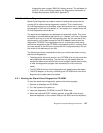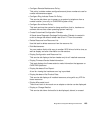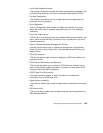160 RS/6000 43P 7043 Models 150 and 260 Handbook
terminal keyboard, to indicate to the system that the customized Boot
Device Order List is to be used. Normally, the first boot device in this list is
your boot disk, which should also contain the bos.diag package.
Note: The term POST indicator refers to the Icons (graphic display), or
device mnemonics (ASCII display) that are displayed while the POST are
executing.
6. Enter any requested password, if set (Power-On or Privileged-Access).
7. Select the terminal type (for example ibm3151 or lft).
Once diagnostics has loaded, you can follow the instructions given on the
console to test your system. After you have tested your system, you should
exit diagnostics by pressing the F3 key and follow the instructions displayed
to shut down AIX. Failure to shut down AIX could result in damage to data on
your disks.
6.3.2 Concurrent Mode
The concurrent mode provides a way to run on-line diagnostics on the system
resources while AIX is up and running.
Since the system is running in normal operation, some resources cannot be
tested in concurrent mode. The following list shows which resources cannot
be tested:
• SCSI adapters used by disks connected to paging devices
• The disk drives used for paging
• Memory
• Processor
There are three levels of testing in concurrent mode:
• The Share-test level tests a resource while it is being shared by programs
running in normal operation. This test is mostly limited to normal
commands that test for the presence of a device or adapter.
• The Sub-test level tests a portion of a resource while the remaining part of
the resource is being used in normal operation. For example, this test
could test one port of a multiport device while the other ports are being
used in normal operation.
• The Full-test level requires the device not be assigned to, or used by,
another operation. This level of test on a disk drive may require the use of
the varyoff operation. The diagnostics display menus allow you to vary off
the desired resource.


















